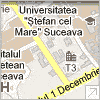Radio identification devices and short range devices laboratory
http://www.emclab.ro/srdrfid.php
OBJECTIVES
The interests of this laboratory are teaching and research in the field of Radio Identification Devices and Short Range Devices. The main objectives are represented by the insurance of a specific and particular environment for research activities, training of the newest generations of engineers and the guarantee of a permanent development of the perspectives regarding both research and didactic activity.
MAIN RESEARCH EQUIPMENT
RFID readers and tags, test and measurement equipments, computers.
MAIN RESEARCH THEMES
The laboratory provided a favourable environment for developing the research activities, reflecting at the same time its real potential of performance and research. The Radio Identification (RFID) Devices and Short Range Devices (SRD) laboratory is furnished with the latest technology to support research, a variety of testing / measuring SRD and RFID equipments is available in laboratory. The two main components involved in a RFID system are the transponder (tags) and the RFID reader.
Test and measurement equipments like
oscilloscopes, spectrum analyzer

Active and passive tags
and other. The tests performed in this laboratory are made in conformity with the equipment specifications and the European standards concerning the RFID and SRD technical characteristics and test methods.
The two components involved in a Radio Frequency Identification (RFID) system are the transponder (tags attached to the object) and the RFID reader (Interrogator). An RFID transponder is a microchip that is attached to an antenna. They come in a wide variety of shapes, sizes and forms and can be read through most materials with the exception of conductive materials like metal and water. Passive tags are generally smaller, lighter and less expensive than those that are active and can be applied to objects in harsh environments, are maintenance free and will last for years. These transponders are only activated when within the response range of a reader. The RFID reader emits a low-power radio wave field which is used to power up the tag so as to pass on any information that is contained on the chip.

For different frequency ranges and
different types of application
Active tags differ in that they incorporate their own power source, where as the tag is a transmitter rather than a reflector of radio frequency signals which enables a broader range of functionality like programmable and read/write capabilities. An RFID reader contains a module (transmitter and receiver), a control unit and a coupling element (antenna).
The reader has three main functions: energizing, demodulating and decoding. Readers can be fitted with an additional interface that converts the radio waves returned from the RFID tag into a form that can then be passed on to another system like a computer or any programmable logic controller. Anti-Collision algorithms permit the simultaneous reading of large numbers of tagged objects, while ensuring that each tag is read only once.

MAIN COLLABORATION
Instituto Politecnico do Porto - Portugal, Universite des Sciences et Technologies de Lille - France, Katholicke Hogeschool Gent - Belgium, Universita degli di studi Catania - Italy
TEAM
Valentin POPA, Professor, Ph.D. Eng. Head of the research team
Phone: +40-744-913-688; +40-230-522978 ext. 231
Fax: +40-230-524-801
E-mail: valentin.popa@usv.ro
SCIENTIFIC CONSULTANTS:
Adrian GRAUR, Professor, Ph.D. Eng.
Dan Alin POTORAC, Professor, Ph.D. Eng.
Vlad CEHAN, Professor, Ph.D. Eng. (T. U. Iasi)
Permanent staff:
Gheorghe SIMIONIUC, Eng.
Adrian PETRARIU, Eng.
3 Ph.D. students
